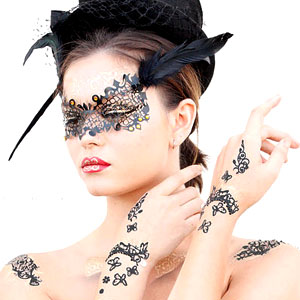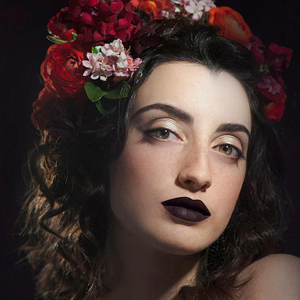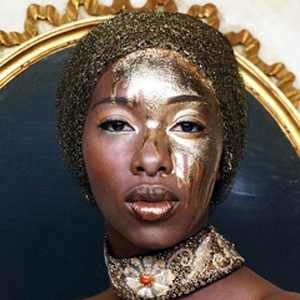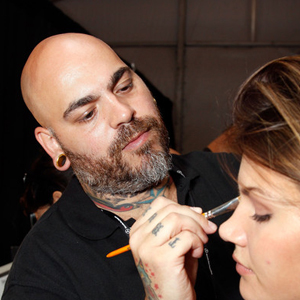Colour Theory
by Phyllis Cohen
Many make-up artists have said that “there are no rules to make-up,” and if you welcome this advice you are probably a make-up junkie who constantly experiments with your make-up. If “no rules” rings untrue, you are probably a make-up phobic suspicious of the whole make-up industry. Using your face as a blank canvas can be fantastic fun, but potentially very time consuming, messy and expensive. If you've got more colours in your make-up drawer than a Gauguin painting and half of them unused, read on for some tips on colour harmony. Basically, if you want to reach a Zen state of colour combination, put together colours that if mixed in a pot would make a neutral grey.
The first colour wheel using pigments was designed in 1810 by Goethe. He used it to illustrate his theory that “when the eye beholds a colour it is at once roused into activity.... to produce another colour forthwith in conjunction with the given one to encompassed the totality of the colour wheel”. Your eyes will always want to see a colour with its complement, which is directly opposite it through the centre of the colour wheel. Therefore, when you see blue, your eye will search for orange, the product of red and yellow (to complete the primary colours of the wheel).
When it sees red it will search for green, the product of blue and yellow. When you see bright flashes of yellow, an afterimage of violet appears, a phenomenon called successive contrast: your eyes need to see violet, the combination of blue and red, the complement of yellow, to redress the whole spectrum of the colour wheel and to make the eyes feel at peace.
Other colour balancing phenomena handy for make-up fanatics is simultaneous contrast. When the eye looks at two colours next to each other it will adjust their relationship to make them look like opposite colours. So, if you have grey-green eyes and want to bring out the green you should surround them with a muted red, a gravy with red wine kind of colour, which would make the green of the eye look bright green, the opposite of dull red. A dull violet on grey green eyes will make them look a brighter yellow green, very striking. The other thing about simultaneous contrast is that the more you look at the two colours the more they will have an impact on each other: your irises will become a more and more vibrant colour, good news for commanding someone's gaze.
Try not to be too smug when you try this technique and everyone comments on how blue, green etc. your eyes look. In fact, spread the word with caution, you don't want to be a killjoy for all those uninitiated make-up junkies spending fortunes on colours they will never wear.
Man Maid
by Phyllis Cohen
On identical female twins, I used highlight, contour and blush colour to transform a half face of one twin into a super-feminised version of herself while I transformed her other twins half face into a super-masculinised version of herself. Understanding the differences between masculine and feminine features and knowing how to play them up or down provides a great starting point for analysing what looks will work or what adjustments will be needed to make a look work on any particular face.
Everyone's face is made up of female and male elements, a wonderful mosaic of masculine and feminine features. Compared to the most sophisticated recognition computers, people can determine the gender of a face in the fraction of the time. The hormonal surge of puberty creates the big differences of a male and female. Testosterone especially changes the bone structure of the face dramatically. It caused the brow bone and jaw to increase substantially and triggers the growth of facial hair.
Oestrogen causes the cheekbones, jawbones and nose to mature and lips to plump out the most they ever will be naturally in a woman's lifetime.
An extremely feminine face is very similar to a young face, big eyes, small nose, delicate jaw, and full lips. Devon Aoki would be an example of a face minimally changed by testosterone. A feminine face with strong cheekbones would be Kate Moss. Most plastic surgery is devoted to achieving more feminine features, smaller noses, and jaw lines, fuller lips, and younger skin.
Men who appear mainly masculine with a element of the feminine are thought to be most attractive. A strong jaw, cheekbones and brow bones but with full lips, or big eyes or small noses, are considered the most handsome. Men that have extremely masculine features without a dose of feminine can suffer from something called the Minotaur syndrome where people will automatically associate this face with a character of extremely aggressive tendencies and stay away.
Divine Lines
by Phyllis Cohen
"No her nose is funny." "This one's lips are too small" Why are we only seeing three quarter angles? Maybe she's really uneven from the front!" "There are no beauty shots she must have terrible skin." "No way, her chin is gigantic!" This is typical of how we in the fashion industry talk when picking a model for a beauty shoot. Shocking behaviour isn't it? We judge purely on physical aesthetics, not on personality or social merit, just the way you do when you look in fashion magazines.
Up until the 1980s social commentators like Naomi Wolfe, author of The Beauty Myth, claimed that the idea of physical "Beauty" was culturally determined as a conspiracy to undermine women's confidence. In 1987, psychologist Judith Langlois, discovered by accident that 3-6 month-old babies looked longer at photographs of attractive faces. Langlois had collected hundreds of photographs of faces and was analysing the response of adults to discern attractiveness, but discovered that even babies had a radar to assess beauty hard-wired into their genetic makeup.
Every woman born into the world has been cast into a global beauty contest without her consent and everyone judges, even babies. According to a model scout, you know you're in the presence of exceptional beauty "when someone walks in the door and you almost can't breathe. You feel it rather than see it." Hence the apt descriptions, "breathtaking", "drop-dead gorgeous", a "knockout".
But for the other 99.5% of us, how do we assess how close we come to any kind of physical ideal. The general consensus of what makes someone attractive is basically a general consensus. If you were to take a thousand pictures of women and use a computer to find the average between all the facial features, long- short, wide- thin, you would end up with an attractive face. In Ancient Greece this idea of physical beauty was made manifest in their classical art. When you look at the Venus de Milo keep in mind that her face was designed to be an archetypal woman. I reckon she was probably a size 14, had a nice face, and slightly frizzy hair. Yup, I'll go along with that!
Along with average features the other key to an attractive face is symmetry. If you draw a straight line down the centre of your face from hairline to chin, are your eyes, lips and cheeks similar in size and shape from right to left? If so, the symmetry supposedly signals a healthy metabolism, likely to produce very healthy babies. This isn't necessarily true, but it is what we have been programmed to interpret. This biological programming is a relic of the make or break mating choices our ancestors faced a few 100 thousand years ago. Yes it is a little outdated with medical advances and average life expectancies three times longer than during the Ice Age, but it still kicks in when we look at faces.
This is the driving force that makes women and men resort to plastic surgery to improve on nature, some to such an extreme that they end up looking rather similar. These over-worked faces become as appealing as the freakish bodies of muscle men, kind of fascinating, but ultimately off-putting.
The website
www.beautyanalysis.com displays the work of Californian plastic surgeon Dr. Maquardt's. Marquardt has used the principle of the "Golden ratio" a mathematical equation long used to calculate the most beautiful forms in nature, to create a mask that fits the planes of ideally proportioned faces. Marquardt superimposes the mask on ethnically diverse and mostly gorgeous faces to prove that the most beautiful faces fit the mask best (Lily Donaldson and Natalia Vodianova would be perfect). Try putting your own face to the test.
Contrary to Marquardt's theory, newer research argues that our brains calculate attractiveness using a best vs worst features algorithm, assessing not whether every feature is perfect, but does the good outweigh the bad. In 2005, a team of computer scientists, Eisenthal, Drer, and Ruppin designed a programme that assessed the attractiveness of 91 faces using an algorithm of comparing facial features on each face. There had been attempts previously to create a programme that could assess beauty the same way we do, but only this one worked because it also used the good vs. bad algorithm.
The Predictor machine and a group of men and women were asked to rate each face from 1-7, 7 being the most beautiful. The machine and humans ratings were strikingly similar. Okay, so adults, babies and now machines can get involved in the global beauty contest, but at least this weighing up good and bad approach is less rigid. This is a much more useful starting point for us 99.5% not so breathtaking folks. We can use makeup and hairstyles and all the other tricks of the fashion and beauty industry to dazzle with our good features!
This flexibility in judgement helps explain the success of models today such as Aygness Dene, who has a slightly larger jawline than the Phi model. Hye Park, with her rounder face or Alana Zimmer and Amanda laing with their exquisitely un-Marquardt profiles. We adore the extraordinary combination of facial features of these distinct beauties. They aren't perfect, but they are idiosyncratically beautiful nonetheless.
Great Kate
by Phyllis Cohen
All these tendencies are part of our human nature, which has evolved slowly over the past two million years.
The theories available are based on very careful guesswork - but there is no doubt when an exquisite face like Kate Moss's captivates us.
Kate's face can be biologically classified as a “sex bomb”. The phenomenon of the “sex bomb” particularly intrigued geneticist Richard Dawkins. In his book, River out the Eden, he tells the story of his old teacher creating a fake female stickleback fish that caused the male sticklebacks to go into a frenzy of arousal. The fake “babe” was a vaguely fish-like silver shape possessing a huge swollen belly as would be displayed by a female laden with ripe eggs -a big turn- on for male sticklebacks. This is a classic example of a “supernormal stimuli", not dissimilar to a creation like Laura Croft. Both “super-babes” have exaggerated fertility signals and the potential to provoke higher levels of arousal in males than a typical example of the real thing.
Kate's face is that of a “Sex Bomb” as are most of the faces we see on fashion magazine covers, but they don't represent “supernormal stimuli” quite as much as Kate.
The face of a “typically” attractive female will have regular, symmetrical features. Average proportions of facial features can be measured in thirds, as the Ancient Greeks used to do. From the hairline to the eyebrows is one third, from the eyebrows to the tip of the nose is another, and from under the nose to the bottom of the chin is the last third. The eyes measure almost halfway down from the top of the head to the chin, and typically are set at distance of one eye-width apart.
Female models differ from this norm in that their eyes, nose and lips are set slightly further down the face. Usually a model's eyes are bigger and set further apart than average, the nose is usually shorter, the lips are fuller and especially higher, and the chin is usually smaller. Essentially, the faces of female models differ form the norm by having features that appear younger.
Kate's face is a more intense version of this already exceptional difference. Having young-looking facial features goes hand-in hand with a face perceived as ultra-feminine. A face like Kate's has all the signs of high female hormone levels. A small chin and delicate jaw-line will advertise that a woman has passed through puberty with minimum amounts of male hormones, which produce a heavier jaw-line.
The anthropologist, Doug Jones, used a computer to analyse the facial proportions of female models in comparison to “average” female faces. When the computer was asked to assess the facial proportions of fashion models, it guessed that they belonged to girls between the ages of six and a half and seven and a half. This does not mean that if we find a female models attractive we must be closet paedophiles: it is quite easy to tell the difference between a seven year old and an adult female with young looking features.
We all know that Kate is not really a little girl, despite the fact that she was hailed as “the super waif".But we can't get enough of her face she seems to trigger some kind of primeval response.
It has been suggested that prehistoric man developed a tendency to seek out these ultra-feminine facial characteristics to choose which mate would have the best reproductive longevity. The women he lusted after were those who appeared to be at the beginning, rather in the prime, of their reproductive life. It is also possible that his preference aided the evolutions of the human skull to become finer and more delicate, particularly in the area of the muzzle and brow-bone. Even 50,000 years ago people preferred refined features. Nobel prize-winner, Konrad Lorenz, once said that the reason Neanderthals were wiped out, was because Homo Sapiens Sapiens came along and everybody thought they were much “cuter".
No one wanted a vulgar Neanderthal when compared to an adorable Homo Sapiens Sapiens. Kate's face is adorable in the extreme, like a “super sex bomb", because the proportions of her facial features are similar to those not of a seven year old, but of a toddler.
Another amazing thing about her face is her lips. Full lips indicate continuing high levels of female hormones. In most women, lips reach their fullest at the age of about fourteen. With the onset of puberty, the body fat is redistributed, and one of the new sites is the lips.
From this point on, their fullness will constantly decrease, but high levels of oestrogen slow the deflating process down. Kate's lips have a particularly distinctive shape: the top lip has a high upward curve towards the centre. These are beyond the full lips of the pubescent girl and like those of a baby. In the eighties, fashion photographers used to tell models to do dumb things like blow air through their lips softly to achieve that pouty look: with Kate it's there already.
Most species are biologically programmed to fall in love with babies. The way a baby looks provokes profound psychological reactions: it makes us want to protect them; it turns off our aggression. The specific type of facial features that elicit these responses are called “neonate": large eyes, small noses, small chin, and widely spaced eyes. Kate's face couldn't fit the bill more closely. Kate is constantly tugging on our heartstrings. And we love it.
Sigmund Freud had a lot to say about the way adults relate to babies. He coined the phrase “his Majesty the Baby” to describe the overvaluation parents bestow on their offspring. When grown-ups watch their young children, they re-live the intense self-importance they once felt themselves as small children. As Freud says, “the child shall fulfil those wishful dreams of the parent which they never carried out - the boy shall become a great man and a hero in his father's place and the girl shall marry a prince as a late compensation for her mother".
It is precisely those cute little noses, big eyes, and sweet rosebud mouths that make us see them as perfect little human beings. Babies can do no wrong, and we idolise them. And Kate.
But, on the top of her cuteness, Kate also possesses something extra - strong cheekbones. This is the facial feature which today represents maturity, and it's important because it signals to men that she is ready to produce off spring. Every epoch has had its preferred sign of facial maturity. In the renaissance it was the long nose, and in Edwardian times it was the double chin. In our own time we have fallen in love with the chiaroscuro produced by film and photographic lighting. Our love affair with cheekbones stems from Hollywood films and their signature lighting on such actresses as Greta Garbo and Marlene Dietrich (the latter had several molars removed to give her the beautiful curved shadows produced by pronounced cheekbones under strong direct lighting.)
The combination of neonatal facial features with very pronounced cheekbones is the secret weapon of Kate's beauty. The maturity her cheekbones suggest, work in direct contrast with the immaturity her other features depict. So on the one hand, we love Kate's faces for its maturity and on the other, we are captivated by its immaturity. We are well and truly hooked.
So there it is: Kate's face has the proportions of a child, the cheekbones of an adult, the jaw-line and lips of an oestrogen laden woman, and the mouth of a baby. Kate's face make us love her, desire her, respect her, and want to nourish and protect her. It's a one-in-a-million face. Subliminally, the big thing her face advertises is that she could have load of kids. The average fertility rate of women using no form of contraception is 8-9 children. This was of great importance during the time of the Great Ice Age, but is it still? Granted, Evolution is a slow process, but nothing lasts forever.
When Kate's face shows its own signs of maturity the chances are, her audience will cease to see her as an object (desired image first, and real person second) and she will become a subject (real person first and desired image second). Her experiences and history will be written all over her face, to the extent that there will be no room for us to project our own fantasies on her anymore. She will not be the perfect repository of our dreams and desires: her face will show traces of her own reality.
Kate Moss is gorgeous. Not many men would dispute that, and a surprising number of women agree. Even forgetting the money, the boyfriends, the glamorous lifestyle, Kate somehow hits the spot. She has an extraordinary beauty.
But such wide-ranging agreement about one face is surprising: men and women tend to prefer very different attributes in a female face, and yet both sexes agree about Kate.
In the Far East, across America and Europe, in the depths of South America or Africa - Kate's face can launch a thousand ad campaigns with unrivalled success. So what makes her so universally attractive?
The rules of attraction have confounded psychologists. In fact it has become a hot topic of debate for geneticists and behaviouralists in the past fifty years. Some theories suggest that we are attracted to facial features that represent high levels of male or female hormones, associated with sexual fertility. Other theories say that we are attracted to what is most familiar -partners like our Mums and Dads.








